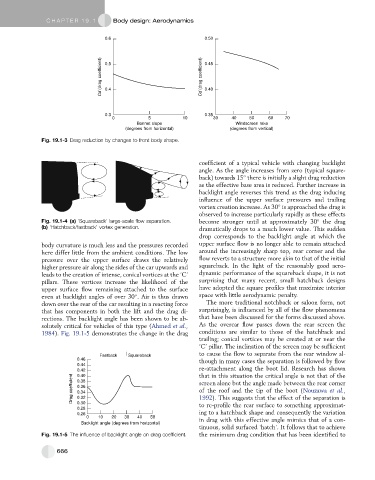Page 656 - Automotive Engineering Powertrain Chassis System and Vehicle Body
P. 656
CHAP TER 1 9. 1 Body design: Aerodynamics
0.6 0.50
Cd (drag coefficient) 0.5 Cd (drag coefficient) 0.45
0.4
0.40
0.3 0.35
0 5 10 30 40 50 60 70
Bonnet slope Windscreen rake
(degrees from horizontal) (degrees from vertical)
Fig. 19.1-3 Drag reduction by changes to front body shape.
coefficient of a typical vehicle with changing backlight
angle. As the angle increases from zero (typical square-
back) towards 15 there is initially a slight drag reduction
as the effective base area is reduced. Further increase in
backlight angle reverses this trend as the drag inducing
influence of the upper surface pressures and trailing
vortex creation increase. As 30 is approached the drag is
observed to increase particularly rapidly as these effects
Fig. 19.1-4 (a) ‘Squareback’ large-scale flow separation. become stronger until at approximately 30 the drag
(b) ‘Hatchback/fastback’ vortex generation. dramatically drops to a much lower value. This sudden
drop corresponds to the backlight angle at which the
body curvature is much less and the pressures recorded upper surface flow is no longer able to remain attached
here differ little from the ambient conditions. The low around the increasingly sharp top, rear corner and the
pressure over the upper surface draws the relatively flow reverts to a structure more akin to that of the initial
higher pressure air along the sides of the car upwards and squareback. In the light of the reasonably good aero-
leads to the creation of intense, conical vortices at the ‘C’ dynamic performance of the squareback shape, it is not
pillars. These vortices increase the likelihood of the surprising that many recent, small hatchback designs
upper surface flow remaining attached to the surface have adopted the square profiles that maximize interior
even at backlight angles of over 30 . Air is thus drawn space with little aerodynamic penalty.
down over the rear of the car resulting in a reacting force The more traditional notchback or saloon form, not
that has components in both the lift and the drag di- surprisingly, is influenced by all of the flow phenomena
rections. The backlight angle has been shown to be ab- that have been discussed for the forms discussed above.
solutely critical for vehicles of this type (Ahmed et al., As the overcar flow passes down the rear screen the
1984). Fig. 19.1-5 demonstrates the change in the drag conditions are similar to those of the hatchback and
trailing; conical vortices may be created at or near the
‘C’ pillar. The inclination of the screen may be sufficient
| to cause the flow to separate from the rear window al-
Fastback Squareback
0.46 though in many cases the separation is followed by flow
0.44
0.42 re-attachment along the boot lid. Research has shown
that in this situation the critical angle is not that of the
Drag coefficient 0.38 screen alone but the angle made between the rear corner
0.40
0.36
of the roof and the tip of the boot (Nouzawa et al.,
0.34
1992). This suggests that the effect of the separation is
0.32
0.30
0.28 to re-profile the rear surface to something approximat-
0.26 ing to a hatchback shape and consequently the variation
0 10 20 30 40 50
Backlight angle (degrees from horizontal) in drag with this effective angle mimics that of a con-
tinuous, solid surfaced ‘hatch’. It follows that to achieve
Fig. 19.1-5 The influence of backlight angle on drag coefficient. the minimum drag condition that has been identified to
666

